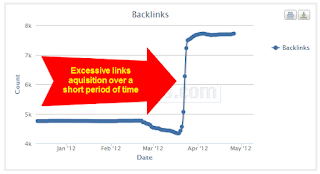Google announced that the websites involving over optimization techniques will be penalized. This result in drop in the ranking positions in the Google search results either with or without notifications due to detection of links related over optimization violations. Google rolled out the first Penguin update on April 24, 2012 to identify web spam. This algorithm change decreased the rankings of the sites which violates the Google's Webmaster Guidelines. Black web spam should be avoided to get quality backlink profile. We need to identify the backlinks and remove the low quality links before the over optimization penalty hits.
Unnatural links occur from the public backlink networks, links from junk content posts, link exchanges, profile link spam, high number of links from blogs/forums, single post blogs, links from irrelevant sites, high number of top-level domain links, comment link spam and high volume of directory links etc.
The following are the links related Over Optimization cases:
Excessive Link Acquisition Check
Acquiring extremely high links is not a good practice. Re-evaluate link building strategies and avoid over optimization. Link acquisition velocity can be checked either by using Ahrefs or Majestic seo.
How to Check for Site-wide Links
High number of site-wide links such as header, footer and sidebar links results in over optimization and site can be penalized. Some of them may occur naturally. A webmaster tool is one of the quickest ways to check your website and detect site-wide links. Check for the links which links several times must be flagged as potential site-wide links and manually checked. The third party service such as Majestic seo, Site explorer and Ahrefs should be used which reports as normal links even though the Google has removed the links from websites from its index.
How to Check for Unnatural Anchor Text Distribution
If all the links in your website has same anchor text then it is known to be over optimized and allowing Google to penalize. It is better to develop natural link profile by creating different variations in anchor text. We can get the anchor text data from different sources like majestic seo and open site explorer.
The following are to be removed in order to filter the data:
Dead Links: These are the sites used to link in the past and no longer link to your site now. The tools used in the 3rd party services are useful in filtering of the dead links.
Deindexed Linking Root Domains: Identify the linking root domains which have been deindexed.
No Follow Links: No follow links causes over optimization and should be removed.
Unnatural Spread of Links Authority
Unnatural link authority spread can be seen on websites who buys more links. Unnatural links include link schemes and buying links. These link profiles come from excessive link building. These unnatural links should be removed from the backlink profile or submit for reconsideration request if cannot be deleted. Too many low authority links leads to over optimization.






